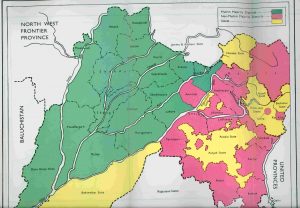Introduction to Punjabi!
Punjab, the “Land of Five Rivers,” is home to a rich and diverse civilization that dates back to prehistoric times. Punjabi is the tenth most commonly spoken language in the world and one of the most respected languages in South Asia. More than 130 million around the world speak this language. The Punjabi language is also prominent in South Asian communities in the United Kingdom, the United States, Canada, and other Asian and African countries.
A Brief History of Punjab

(https://upload.wikimedia.org/wikipedia/commons/c/c5/Punjab-religion-2.jpg)
Punjab is a state in northwest India along the borders of India and Pakistan. “Punjab” is derived from the Persian word “Punj” meaning five and “ab” meaning water. Hence, the literal meaning of Punjab is the “land of five rivers.” The region of Punjab has a rich history due to its geographic location. As it was the primary entry point into India from abroad, Punjab became the target of various invasions by foreigners, including the Persians, Greeks, Aryans, Egyptians, Afghans, and Mughals. Punjab gradually became a melting pot of different races and ethnic backgrounds, and the distinctive culture and heritage we see today is mainly due to it being the hub of invading empires throughout history. Prior to the partition of 1947, there existed one large Punjab province, encompassing the modern-day Indian states of Punjab, Haryana, Delhi, and Himachal Pradesh, and the present Pakistani state Punjab. Due to it being the home of people of many different religions, the province became the focal point of the partition of India and Pakistan. The partition split the former British Indian Empire into two independent nations: the Western section, consisting predominantly of Muslims, became what is known today as Pakistan, while the Eastern section became India. The partition also split the Punjab province into two, shared by the two newly-formed nations.
Punjabi Language
The people of Punjab, regardless of residing in Eastern or Western Punjab, are known as Punjabis and speak the same language as well, with some variation. Sanskrit is the mother language of the northern region of India from which many languages, including Punjabi, have arisen. Punjabi is the successor to a medieval language Sauraseni Prakrit, which was a language that stemmed from Sanskrit. The dialect of Punjabi emerged from the Sauraseni Apabhramsa. The literacy era of the language flourished during the Bhakti movement. The Punjabi language has many similarities to other languages. In fact, Punjabi has absorbed numerous words from both Persian and Arabic languages, an indication of the Muslim presence in Punjab from countless invasions and occupations of the province. It is because of these invasions by Persian/Arabic groups that Punjabi has two different forms of the script, Gurmukhi and Shahmukhi. Gurmukhi is influenced by the Sanskrit, whereas the Shahmukhi script is influenced by the Arabic Abjad. This manual will focus on the Gurmukhi script. This blossoming script of Punjabi has dialectal differences based on the region the language is spoken in. Punjabi shares the characteristic of various other languages in that it has different dialects in different geographic regions. Today, over 28 million people speak the eight known dialects. Majhi is spoken in the heartland of Punjab, spanning from Pakistani Punjab to Indian Punjab. Pothowari is known to be mainly in North Pakistan Punjab. Jhangochi, also known as Rachnavi, is the eldest and most idiosyncratic dialect of Punjabi, spoken mostly in Pakistan Punjab. Another dialect mostly known to the Pakistan area of Punjab is Shahpuri, spoken mainly in towns surrounding Shahpur. Hindko is spoken mostly in the Northern Punjab region of Pakistan as well as the North-West Frontier Province. Malwi, Doabi, and Pwadhi are all spoken in Indian Punjab. Malwi is spoken mainly in central and southern Punjab, whereas Doabi is the dialect used in the lands between two rivers (hence “do-ab-i”). Pwadhi is the major dialect spoken in the southern regions of Punjab, in and around the Haryana state. Punjabi has a syllabic script, which means words lack letters and are composed of syllables instead. The script is made in such a way that each syllable’s sound can be altered with the use of another character in the script, known as the modifier. The script consists of 35 characters, each of which is unique in sound and expression. This precise system is known as “Painti” (literally meaning thirty-five) and is designed to have patterns in terms of pronunciation and use.